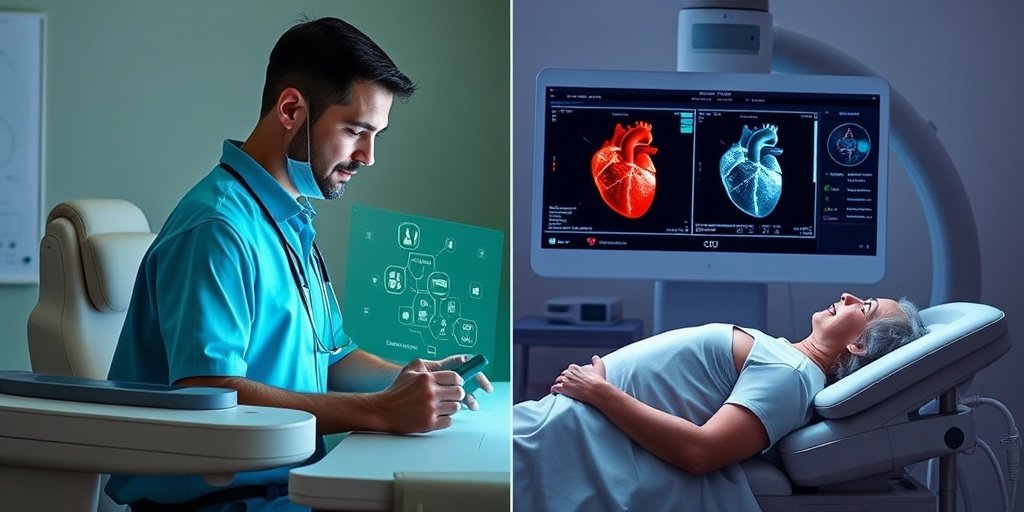⚡ Quick Summary
A recent study explored the potential of automation and artificial intelligence (AI) in reducing the time required for transthoracic echocardiograms (TTEs). The findings revealed that an advanced scanning protocol could significantly decrease both scan time and ultrasound system interaction without compromising image quality.
🔍 Key Details
- 📊 Study Design: Comparison of two TTE protocols involving volunteer participants.
- ⚙️ Protocol A: Utilized automation, AI-assisted acquisition, and multiplane imaging.
- ⚙️ Protocol B: Standard scanning protocol without advanced technologies.
- 🕒 Scan Time: Protocol A: 13.4 ± 2.3 min vs. Protocol B: 18.0 ± 2.6 min.
- ⌨️ Keystrokes: Protocol A: 230.9 ± 24.2 vs. Protocol B: 502.8 ± 56.2.
🔑 Key Takeaways
- 🤖 Advanced technologies like AI and automation can streamline echocardiography workflows.
- ⏱️ Significant reduction in scan time (4.6 ± 2.9 min) with the advanced protocol.
- 💻 Fewer keystrokes required, enhancing efficiency for sonographers.
- 📉 Ergonomic benefits observed, with a 27% decrease in reaching beyond a neutral position.
- 🔍 Image quality and interpretability remained intact with the new protocol.
- 🏥 Potential for improved patient throughput in clinical settings.
- 🌟 Study conducted by researchers at Echo Research Practice.

📚 Background
The demand for transthoracic echocardiograms (TTEs) has surged, leading to increased workloads for cardiac sonographers. This rise in demand has been associated with a higher incidence of work-related musculoskeletal pain. The integration of modern technologies such as AI and automation presents an opportunity to optimize workflows, potentially alleviating some of the ergonomic burdens faced by sonographers while maintaining high standards of patient care.
🗒️ Study
The study involved volunteer participants who underwent two TTEs using different protocols. Protocol A incorporated advanced technologies, including automation and AI-assisted imaging, while Protocol B followed a traditional scanning approach. The aim was to evaluate the effectiveness of the advanced protocol in reducing both scan time and the interaction required with the ultrasound machine.
📈 Results
The results were compelling: Protocol A demonstrated a significant reduction in both scan time and keystrokes compared to Protocol B. Specifically, the average scan time was reduced by approximately 4.6 minutes, and the number of keystrokes decreased by 271.9 keystrokes on average. These findings suggest that the advanced protocol not only enhances efficiency but also supports the ergonomic well-being of sonographers.
🌍 Impact and Implications
The implications of this study are profound. By adopting a TTE protocol that leverages AI and automation, healthcare facilities can improve operational efficiency while safeguarding the health of their staff. This advancement could lead to better patient care through faster and more efficient echocardiographic assessments, ultimately enhancing the overall healthcare experience.
🔮 Conclusion
This study highlights the transformative potential of automation and AI in the field of echocardiography. By reducing scan times and minimizing the physical strain on sonographers, these technologies pave the way for a more efficient and sustainable approach to cardiac imaging. Continued research and implementation of such innovations are essential for the future of healthcare.
💬 Your comments
What are your thoughts on the integration of AI and automation in echocardiography? We would love to hear your insights! 💬 Share your comments below or connect with us on social media:
Can automation and artificial intelligence reduce echocardiography scan time and ultrasound system interaction?
Abstract
BACKGROUND: The number of patients referred for and requiring a transthoracic echocardiogram (TTE) has increased over the years resulting in more cardiac sonographers reporting work related musculoskeletal pain. We sought to determine if a scanning protocol that replaced conventional workflows with advanced technologies such as multiplane imaging, artificial intelligence (AI) and automation could be used to optimise conventional workflows and potentially reduce ergonomic risk for cardiac sonographers. The aim was to assess whether this alternate protocol could reduce active scanning time as well as interaction with the ultrasound machine compared to a standard echocardiogram without a reduction in image quality and interpretability.
METHOD AND RESULTS: Volunteer participants were recruited for a study that comprised of two TTE’s with separate protocols. Both were clinically complete, but Protocol A combined automation, AI assisted acquisition and measurement, simultaneous and multiplane imaging whilst Protocol B reflected a standard scanning protocol without these additional technologies. Keystrokes were significantly reduced with the advanced protocol as compared to the typical protocol (230.9 ± 24.2 vs. 502.8 ± 56.2; difference 271.9 ± 61.3, p < 0.001). Furthermore, there was a reduction in scan time with protocol A compared to protocol B the standard TTE protocol (13.4 ± 2.3 min vs. 18.0 ± 2.6 min; difference 4.6 ± 2.9 min, p < 0.001) as well as a decrease of approximately 27% in the time the sonographers were required to reach beyond a neutral position on the ultrasound console.
CONCLUSIONS: A TTE protocol that embraces modern technologies such as AI, automation, and multiplane imaging shows potential for a reduction in ultrasound keystrokes and scan time without a reduction in quality and interpretability. This may aid a reduction in ergonomic workload as compared to a standard TTE.
Author: [‘Hollitt KJ’, ‘Milanese S’, ‘Joseph M’, ‘Perry R’]
Journal: Echo Res Pract
Citation: Hollitt KJ, et al. Can automation and artificial intelligence reduce echocardiography scan time and ultrasound system interaction?. Can automation and artificial intelligence reduce echocardiography scan time and ultrasound system interaction?. 2025; 12:11. doi: 10.1186/s44156-025-00077-0